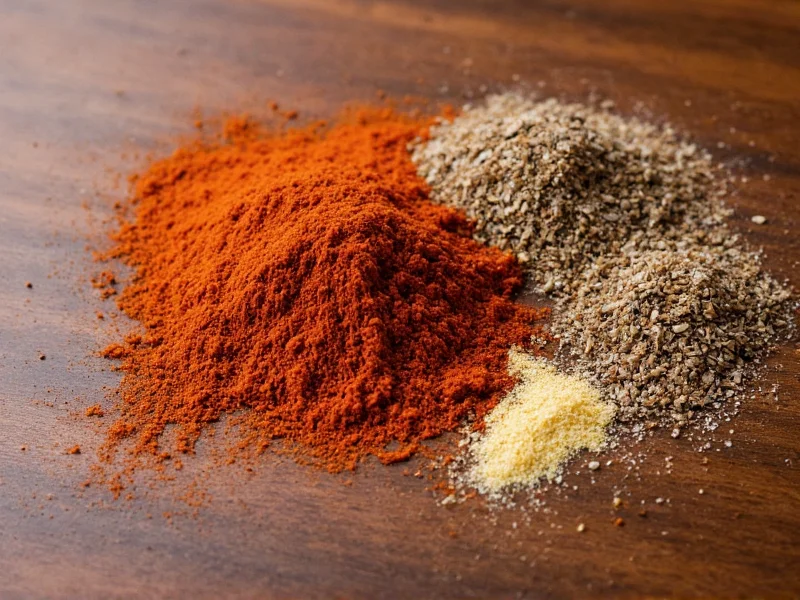When navigating menus or recipes, understanding spice level indicators can transform your culinary experience. This comprehensive guide explains how spice levels are measured, interpreted, and managed across different contexts. Whether you're dining out, cooking at home, or exploring global cuisines, knowing how to assess and communicate your spice preferences ensures you get the flavor experience you desire without overwhelming heat.
How Spice Levels Are Measured
The Scoville Organoleptic Test, developed in 1912 by Wilbur Scoville, remains the foundation for measuring spiciness. This method determines how much sugar water is needed to dilute a pepper extract until its heat is no longer detectable by a panel of tasters. Modern laboratories now use high-performance liquid chromatography (HPLC) for more precise measurements, but results are still expressed in Scoville Heat Units (SHU) for consumer understanding.
Understanding spice level measurement systems helps consumers make informed decisions when encountering unfamiliar dishes. The transition from subjective tasting panels to objective laboratory testing has made spice level information more reliable and consistent across different products and restaurants.
Common Spice Level Indicators
Restaurants and food manufacturers use various systems to communicate spice levels to consumers. These indicators range from simple descriptive terms to numerical scales or visual symbols. Recognizing these indicators helps you select dishes that match your heat tolerance while expanding your culinary horizons at a comfortable pace.
| Spice Indicator | Typical Meaning | Scoville Range | Common Applications |
|---|---|---|---|
| Mild | Subtle warmth, minimal heat | 0-5,000 SHU | Poblano peppers, paprika-based dishes |
| Medium | Noticeable heat that enhances flavor | 5,000-30,000 SHU | Jalapeño-based sauces, many Indian curries |
| Hot | Significant heat requiring caution | 30,000-100,000 SHU | Habanero salsas, some Thai dishes |
| Very Hot | Intense heat for experienced eaters | 100,000-350,000 SHU | Sriracha, some Mexican hot sauces |
| Extreme | Overwhelming heat, not for casual consumption | 350,000+ SHU | Ghost peppers, Carolina Reaper products |
Regional Variations in Spice Level Expectations
What constitutes "hot" varies dramatically across cultures. In Thailand, a dish labeled "medium" might contain multiple bird's eye chilies that would qualify as "extreme" in many Western restaurants. Understanding regional spice level expectations prevents unpleasant surprises when exploring international cuisines.
Indian restaurants often use a 1-5 scale where 3 represents substantial heat, while Mexican establishments might use jalapeño-based references. Japanese spice levels typically focus on the gradual build of heat from ingredients like togarashi, whereas Korean cuisine emphasizes the immediate punch of gochugaru. When dining at ethnic restaurants, don't hesitate to ask staff about their specific spice level indicators and how they compare to what you're accustomed to.
Factors Affecting Perceived Spiciness
Several elements influence how spice level registers on your palate beyond just the pepper variety:
- Food matrix: Fatty foods like coconut milk in curries can mitigate heat perception
- Acidity: Lime or vinegar can enhance the perception of heat
- Temperature: Hotter foods deliver more intense spice sensations
- Individual tolerance: Regular exposure to capsaicin increases heat tolerance over time
- Genetic factors: Some people naturally have more heat receptors than others
Understanding these factors helps explain why the same dish might register differently on various occasions or for different people. This knowledge is particularly valuable when trying to replicate restaurant-quality spice levels at home or when adjusting recipes for different diners.
Determining Your Personal Spice Tolerance
Building spice tolerance should be a gradual process. Start with mild peppers like poblanos or Anaheim chilies, then progress to medium varieties like jalapeños before attempting hotter options. Pay attention to how your body responds—not just the immediate burn but any digestive effects afterward.
When ordering at restaurants, begin with dishes described as "mild" or "medium" and communicate clearly with staff about your heat preferences. Many establishments will adjust spice levels upon request if you ask before ordering. Remember that spice tolerance is highly individual—what seems mild to one person might be overwhelming to another, and there's no shame in preferring less heat.
Practical Tips for Managing Spice Levels
Whether you've ordered a dish that's too spicy or want to control heat in your cooking, several effective strategies exist:
- Add dairy products like yogurt or sour cream to counteract capsaicin
- Incorporate starches such as rice or bread to absorb excess heat
- Balance with sweet elements like honey or fruit
- Remove seeds and membranes from peppers before cooking (where most capsaicin resides)
- Start with less spice than you think you need—you can always add more later
When cooking, add spicy elements gradually and taste frequently. Remember that heat intensifies as dishes cook and often becomes more pronounced after resting. For restaurant situations, don't hesitate to ask for modifications—most establishments appreciate the opportunity to adjust dishes to your preference rather than receive negative feedback after the fact.
Communicating Spice Preferences Effectively
When dining out, clear communication about your spice preferences prevents disappointment. Instead of simply saying "not too spicy," try more specific requests like "medium heat with the option to add more" or "mild but with visible peppers so I can remove them." Many restaurants appreciate these precise requests as they help kitchen staff prepare dishes that better match your expectations.
When ordering delivery or takeout, include special instructions about spice level in your order notes. For international cuisines, research common spice level terms beforehand—knowing that "pedal" means mild in Thai or "sin picante" means no spice in Spanish can prevent unpleasant surprises.











 浙公网安备
33010002000092号
浙公网安备
33010002000092号 浙B2-20120091-4
浙B2-20120091-4